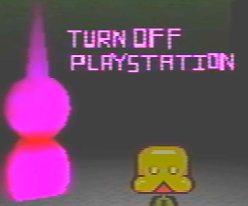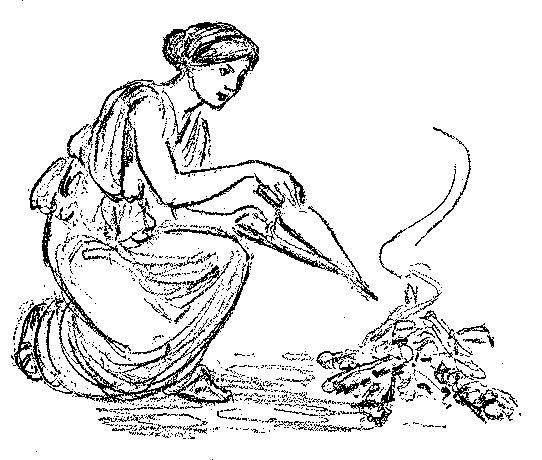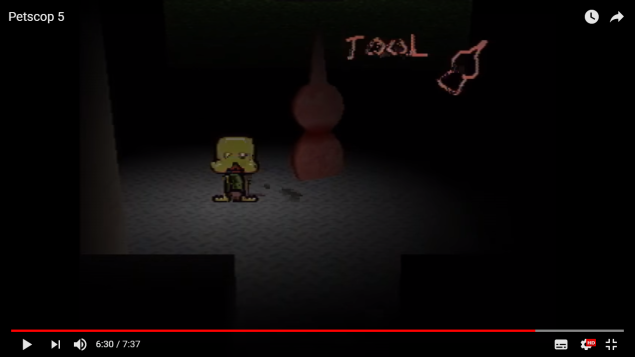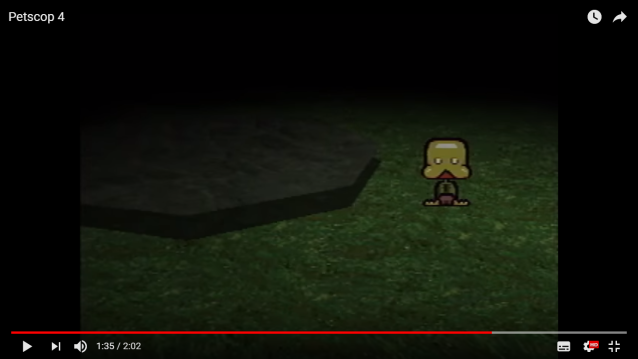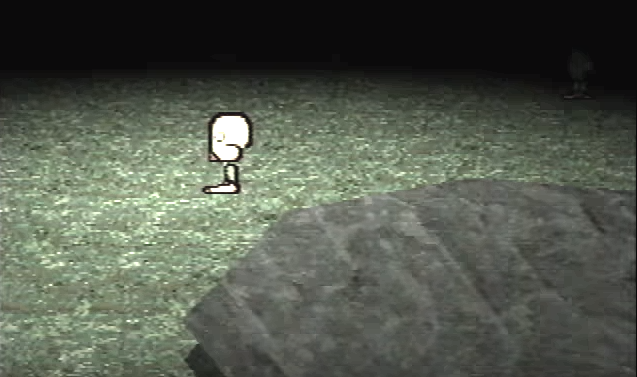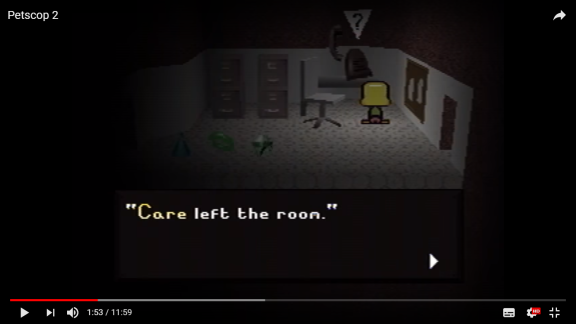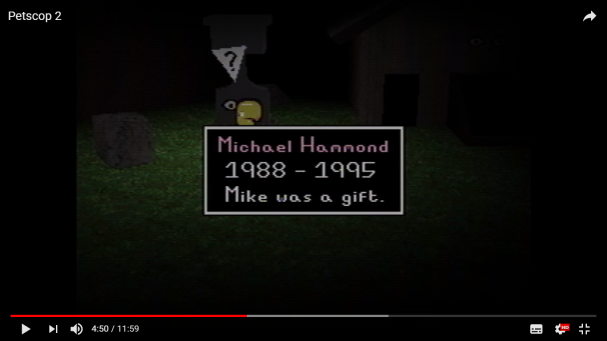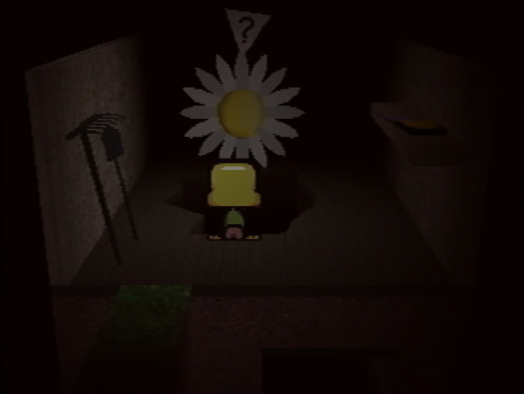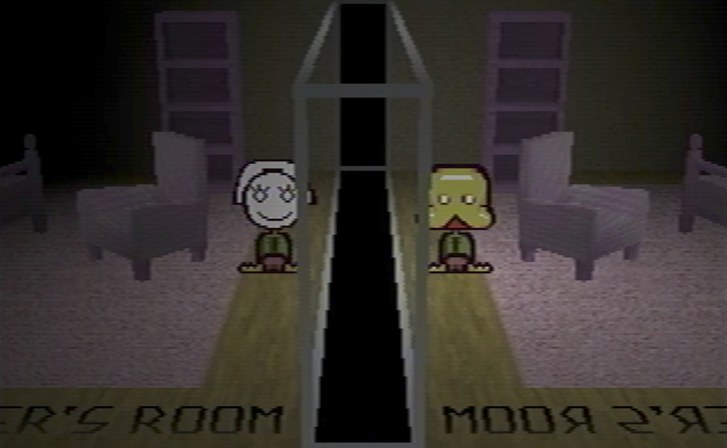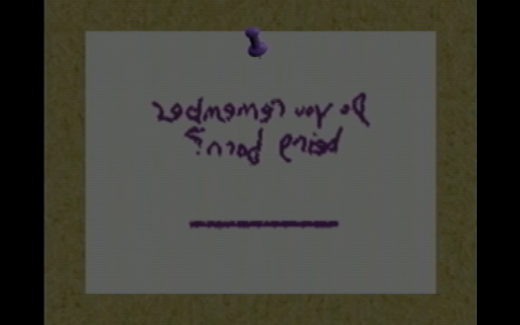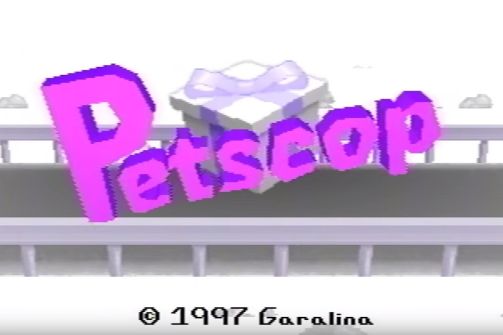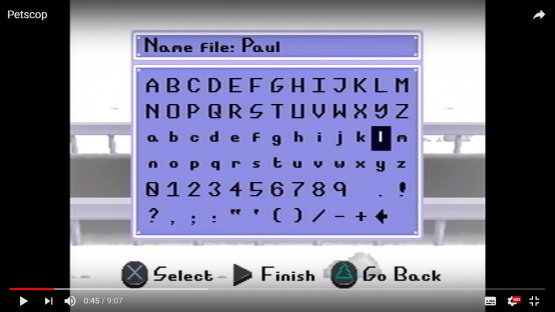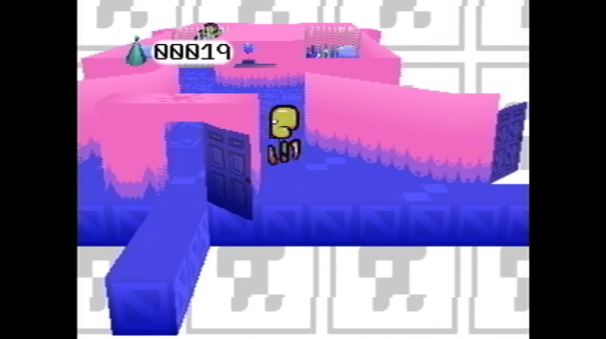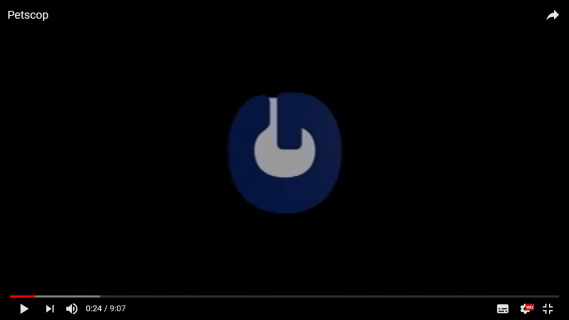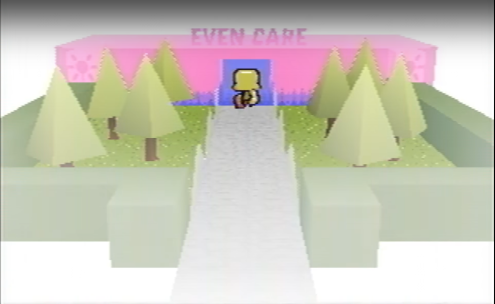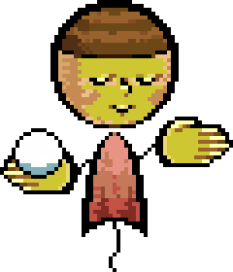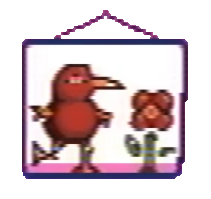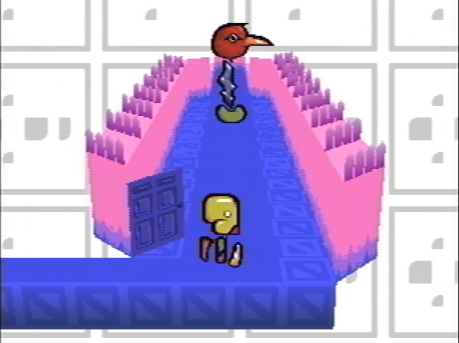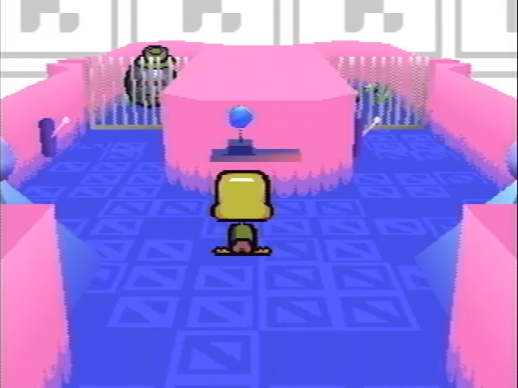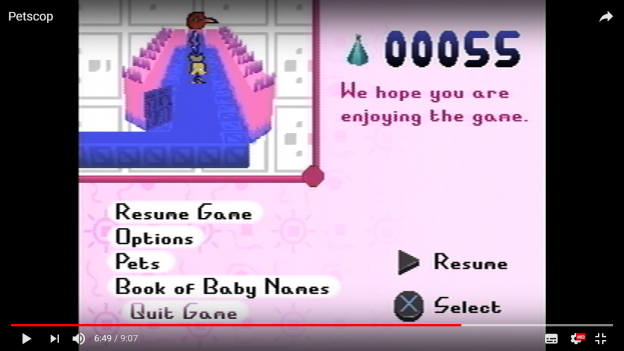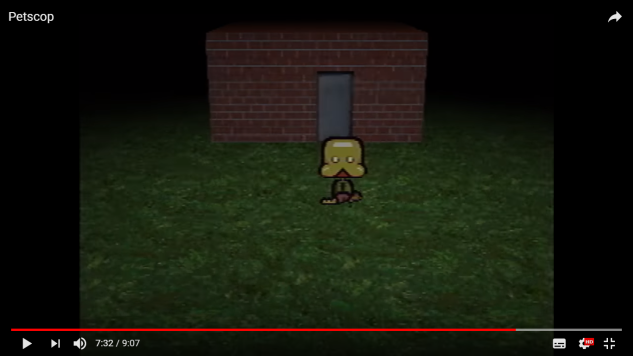Video 3 was uploaded on April 2, 2017, just one day after Video 2 appeared. Again, the video bore no description.
This part of the game provides more insight into what’s going on in Petscop than any other element of the game, hands down. It introduces us to several characters who will appear inside (and perhaps outside) the game, and partially reveals the intent of the game’s (fictional) creator.
In my opinion, it is the most disturbing part of the game.
A Word of Caution
I don’t use the word “triggering” lightly, and I do not hesitate to warn you that for some people, the events of the Child Library may cause emotional distress.
I know this to be true because I experienced some emotional distress. Like the character(s) Care, who plays a central role in the events, I was subject to abuse in early childhood.
As a result of the trauma and stress, I made a habit of plucking out my eyelashes. Although I did not know it until years later, the compulsion to pull out hair/eyebrows/eyelashes (Trichotillomania) sometimes develops in children who have undergone trauma. This is certainly not to say that all children with Trichotillomania have been abused or traumatized, but if you observe a child exhibiting this behaviour for no easily discernible reason, it would be a good idea to ensure that the child is not under any abnormal stress.
I will explain why these things are relevant to Petscop in the sections titled “Michael’s Bedroom” and “Care’s Bedroom”, but if you think reading about child abuse will be emotionally difficult for you, please proceed with caution.
———–
At the start of Video 3, Paul is back Under the Newmaker Plane. He enters a corridor absolutely loaded with tokens. Carved into the wall in huge letters, as though out of rock, are the words GOOD GRIEF AND ALAS, another direct quotation from Daisy-Head Mayzie.
The Child Library
At the end of this corridor, Paul finds a small, sliding door in a brick wall, similar to the entrance to a dumbwaiter or a bookdrop at a library. He examines the door, opening it and closing it.
He then enters an anteroom in which the bookdrop itself is located. There is an unusually narrow doorway in the far wall. There is also an easel set up in the foreground. On the easel is a gray placard with eyes and a nose, reminiscent of the eyes on Michael’s gravestone and above the door leading to the basement of the garden shed.
Paul finds that he can manipulate the facial features on the easel, selecting slightly different eyes, noses and eyebrows (but no mouths) to create different faces.
When he chooses a face, the anteroom begins to shake, and movement outside the doorway indicates that the room is moving very rapidly. This could be the plummeting of an elevator, but the shaking and the quaking noise that accompanies it remind me of the film Cube, in which a vast labyrinth made up of square, interconnected rooms rearranges itself periodically like that crazy proposed skyscraper in Dubai, making escape nearly impossible. I should add that Cube was released in 1997.
However, Paul is able to exit into the GOOD GRIEF corridor, and it is not quaking. When he re-enters the anteroom, the shaking has stopped and Paul selects another face on the easel. This time, the quaking goes on for so long that Paul finally stops playing and shuts off the video. When the video resumes, the quaking has stopped and Paul tells us it went on for about 10 minutes. He is now able to pass through the narrow doorway into a child’s bedroom.
Each time Paul creates a new face on the anteroom easel, the anteroom quakes for a while and a new child’s bedroom appears beyond the doorway.
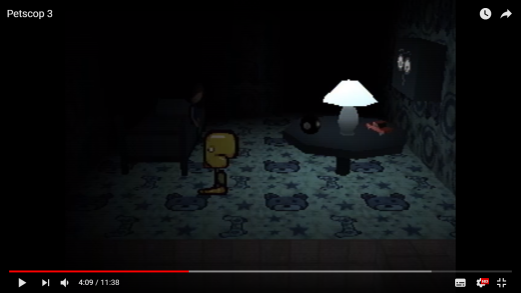
the first bedroom Paul enters in the Child Library
The Child Library Bedrooms
Each room is identical in layout. In the foreground there is a small table illuminated by a lamp. There are two toys, one on either side of the lamp, that vary with the room. These toys include both familiar, brand-name playthings (a Rubik’s Cube, a PEZ dispenser, a can of Play-Doh, a Magic 8-Ball) and unusual items (a pair of tweezers, a small-scale Tool, a model car that looks identical to vehicles seen elsewhere in the game). Hanging on the wall above the table is a square object, possibly a cabinet, bearing the same face as that on the easel. Each face corresponds to a certain child. In the far left corner of each bedroom is a bed, which is barely visible by the light of the table lamp. Motionless figures can be seen sitting on the edge of the beds in most of the Child Library bedrooms, the notable exceptions being Mike’s room and Care’s room. Paul does not interact with the children in any way, and they do not respond to his presence.
The bedrooms differ not only in the toys on display, but in the pattern and colour of the carpeting and wallpaper. We later learn that these bedrooms are part of a Child Library, a sort of museum or zoo in which children caught as “pets” can be deposited. The bedrooms could serve as cages or display areas for such “pets.”
The word “library” is telling. It would be more appropriate for the place to be called an orphanage. “Library” hints that the children may be available for viewing – or for loan – to patrons. When Paul later deposits Care NLM into the Child Library, using the “bookdrop” in the wall, popup text informs him that he can reclaim Care NLM at any time within the next six months. And we will learn much later that a girl who could be the “real” (outside the game) Care, and is exactly the same age as Paul, vanished for six months.
At least two of the child bedrooms contain lengthy notes that provide a great deal of insight into what is happening in Petscop – and possibly outside of it, as well.
Paul doesn’t know quite what to do with the Child Library at first, so he returns to the garden area for a short time. After some thought, he goes back to the Child Library easel and recreates the face on Michael’s grave.
A message pops up: “Mike is not inside right now. He is dead. You may visit his room.”
Michael’s Bedroom
Mike’s bedroom has red carpeting with a pattern of circles and clown faces. On the table are a miniaturized Tool and what appears to be a pair of tweezers. We will soon learn that Care does not have eyebrows, and these tweezers (if that’s what they are) could indicate that the children associated with the Child Library remove their own eyebrows (suggesting Trichotillomania).
Obviously, there is no child on the bed in this room.
Paul next arranges Care’s features on the easel, which informs him that “Care is missing.”
Care’s Bedroom
This bedroom is colourless, except for the two items on the table: Another miniature replica of Tool and a box of crayons (identical to the one on the shelf of the garden shed). The carpet pattern features daisies and, oddly yet appropriately, paint rollers. There is no child on the bed because Care is still in the basement of the garden shed, in distorted red form.
There is a note attached to the far wall of the bedroom, and Paul examines it, bringing up a series of text boxes. This is where shit gets crazy. Take a look at the very first line of the note in the screenshot below. First of all, we don’t know precisely who “you” is supposed to be, but this note establishes that he’s probably Care’s father. Paul is certain the “you” isn’t aimed at him, as it was in the signs of the Gift Plane.
Secondly, take note of the purple text that denotes the wife (presumably Care’s mother). Recall that in Video 2, all of the furniture in the Mirror Room is purple, and the “Do you remember being born?” poster on the wall has purple text. The shades are not identical, however.

Here is the next portion of the note:
“You say, ‘That’s a puzzle.’
You’re secretly very excited to hear this news.
You’re in the bathtub thinking about her.
I have a guess at which child you’ll pick next.
When you find her room, the passage to my right will lead to her.
She’ll appear from the darkness, limping, and I’ll shoot her in the head.”
Not even Paul can be blasé about this. “What am I reading?” he mutters.
There is much to process at this point. First, “That’s a puzzle,” appears in green text. We haven’t yet seen green text at this level of the game (but it is associated with Randice, the flower-pet that Paul caught in Even Care). It could be associated with a character who appears later, Marvin. Marvin is also known as the Green-Faced Man, and he will show up in the flesh (so to speak) in a later video. Marvin may also be the Shadow Monster Man mentioned in the note that Paul found with the game.
The next three lines of the note are tremendously disturbing, and I don’t think I need to go into the reasons why. They still seem to refer to Care’s father (Marvin?).
But then we come to “When you find her room…” That seems to be directed squarely at the player of the game, who is “finding rooms.” And there are hidden passages to the right of where the note is located in each of the Child Library bedrooms. We will see a doppelganger of Paul vanish into one of them later in the game.
“I” is unknown, as is the “child you’ll pick next.” Obviously, though, “I” could be the game creator – and a note found in a Child Library bedroom at a later date suggests that a mysterious figure calling himself Rainer is the original creator of the game. The thing is, Petscop could have more than one developer. Remember from Video 1 that it is copyrighted 1996. Yet in later videos, events of 1997 and 2000 are referenced, hinting that someone added to the game. We will also learn that at least one other person with whom Paul comes into contact has played Petscop, and tells Paul about a tunnel in a very specific location under the Newmaker Plane. When Paul tries to find it, it’s gone.
The next significant Child Library that Paul will select (in a later video) does not even belong to a specific child; he experiments with the easel by combining Care’s eyes and nose with Mike’s eyebrows. The results will be very peculiar.
Here is next line of the note:
Tiara says young people can be psychologically damaged ‘beyond rebirthing.’
Tiara’s name and her quote are not in exactly the same shade of purple as the text associated with the wife/Care’s mother, but is there some connection between them?
The reference to “rebirthing” brings to mind the childishly handwritten “Do you remember being born?” poster in the Mirror Room, and a later Child Library note claims that Care is the reincarnation of a girl who vanished in 1977 along with a windmill.
At this point, we should examine the 2000 child death that I mentioned in my overview of Video 2. This aspect of Petscop is firmly entrenched in its lore and forms the basis of most superficial commentary on the series, but I don’t believe that what follows is central to the storyline. In my opinion, the references merely help establish the themes of child abuse and the mistreatment of adopted children. I have delayed discussing the Newmaker case because I wanted to de-emphasize it and focus on what I see as more germane themes.
However, this case is of great importance to me, because I have written previously about the mistreatment of adopted children who are diagnosed with “Reactive Attachment Disorder.” I have also examined some of the bogus treatments and (sometimes fatal) punishments that have been used to deal with RAD-diagnosed children, and will be addressing related issues on another blog (Swallowing the Camel) in the future.
The Candace Newmaker Case
In 2000, Jeane Newmaker was struggling with her adopted 10-year-old daughter, Candace (born Candace Tiara Elmore). Candace had been diagnosed with “Reactive Attachment Disorder”, which is characterized by behaviour that one should expect from children who have been removed from their natural homes.
There were several treatment options available to Jeane Newmaker. Unfortunately for Candace, she selected one that isn’t practiced or condoned by many reputable, professional therapists: Attachment therapy. Attachment therapy is predicated on an array of sketchy notions, notably the idea that if an adopted or foster child acts out in any way, it’s because the child has failed to bond properly with his/her caregivers and must work through his/her suppressed rage, abandonment issues, etc. Many people adopted as children, including Beth Thomas (the subject of the HBO documentary Child of Rage), have testified to the efficacy of attachment therapy. Other people adopted as children are dead because of it.
Jeane Newmaker was referred by a psychologist to one of the most prominent and influential attachment therapists in the U.S., Connell Watkins of Evergreen, Colorado. Watkins had treated Beth Thomas in the late ’80s-early ’90s using a system of strict rules and privilege-earning. By the time Jeane Newmaker paid $7,000 for an intensive two-week round of attachment therapy at the Attachment Center in Evergreen, Watkins was an avid practictioner of both holding therapy and rebirthing.
Holding therapy consists of swaddling and holding a child, against his/her will if necessary, in order to invoke cathartic outbursts of anger. The real aim of the holding method, I would argue, is to break the child’s will and make them more compliant.
“Rebirthing” is even less sensible. It is centred largely on the notion of psychological birth trauma (which is so absurd that Scientologists have embraced it), and the goal is to simulate the birth process so that the RAD-afflicted child can work through the awful things they must have experienced in their birth mother’s womb and be “reborn” into a good family.
For two weeks, Candace underwent “therapy” with Watkins and a small team consisting of psychologist Julie Ponder and two “therapeutic foster parents.”
At the end of that period, it was time for Candace’s rebirthing. Watkins, Ponder, the two “foster parents”, and Jeane Newmaker gathered around Candace inside a small room at the Attachment Center. Candace was wrapped up tightly in a flannel sheet. The four members of the therapy team then proceeded to push on Candace with their hands and feet so that she would have to fight to “be born.” Throughout the first 40 minutes of this lunacy, Candace repeatedly protested, pled to be unwrapped, and even screamed for help. She was in obvious distress. She vomited and soiled the sheet, but the team continued to harangue her about being born. Candace told them she was dying.
Julie Ponder responded with further taunts, including “Quitter, quitter, quitter, quitter! Quit, quit, quit, quit. She’s a quitter!”
After an hour, Candace had still not been reborn. She was, in fact, completely motionless. Jeane Newmaker pouted that this made her feel very rejected.
Watkins probably realized at this point that something wasn’t right. She shooed everyone but Julie Ponder out of the room, then unwrapped Candace, who appeared to be sleeping.
Candace had been unconscious for over 20 minutes, asphyxiated. She was declared brain-dead the next day.
Watkins and Ponder had videotaped the entire session, and this was presented as evidence at their trials for reckless child abuse resulting in death. Both women were convicted and sentenced to 16 years in prison. Watkins was released in 2008, seven years into her sentence. We can safely assume that Ponder didn’t serve her full sentence, either.
The good news in this terrible story is that Candace’s death drew critical scrutiny to attachment therapy, and Watkins was barred from conducting therapy with children as a condition of her release.
———–
I entertain no doubts that the Petscop references to Newmaker, rebirthing and “pets” were intended to draw attention to the death of Candace Newmaker and the mistreatment of adopted children. For that, I am grateful. It could be argued that Ms. Newmaker, whatever her intentions, was treating her adopted child more like a naughty pet that had to be retrained to suit her own needs than as an actual child with independent needs, and that sort of behaviour is disconcertingly common in adoption cases involving foreign, abused/neglected, and RAD-diagnosed children.
Dangerous pseudotherapeutic practices deserve our attention, and attachment therapy is still with us. The Attachment Center in Evergreen, Colorado was renamed the Institute for Attachment and Child Development and continues to treat children with “Reactive Attachment Disorder” using attachment therapy.
Whew. Okay. That’s out of the way. Let’s move on to the rest of the note:
“A young person walks into your school building.
They walk in with you. You’re holding their hands.
They came out crying into their hands, because nobody will love them, not ever again.
‘Nobody loves me!’
They wander the Newmaker Plane.”
“Nobody loves me!” appears in yellow text, further reinforcing the connection between Daisy- Head Mayzie and Care. We can infer from this part of the note that Care was abused at the school (the brick building), possibly by her own father and/or someone who worked at the school. Later in the game, there are suggestions that Marvin worked at the school, possibly as a music teacher.
Paul remains standing in front of the note after reading it, and ponders its nature. He says the game, or this portion of it, could have been made for a specific person. “Not me, certainly.”
Paul then exits the child library, eager to check out the door at the very end of the GOOD GRIEF AND ALAS corridor. To his dismay, the doorway leads into an empty black expanse.
This is the first video that suggests the game is re-creating or re-imagining events that occurred outside the game. Someone has either modified an existing children’s game to turn it into an accusatory message directed at Care’s father, or someone has created a game from scratch to do the same thing.
